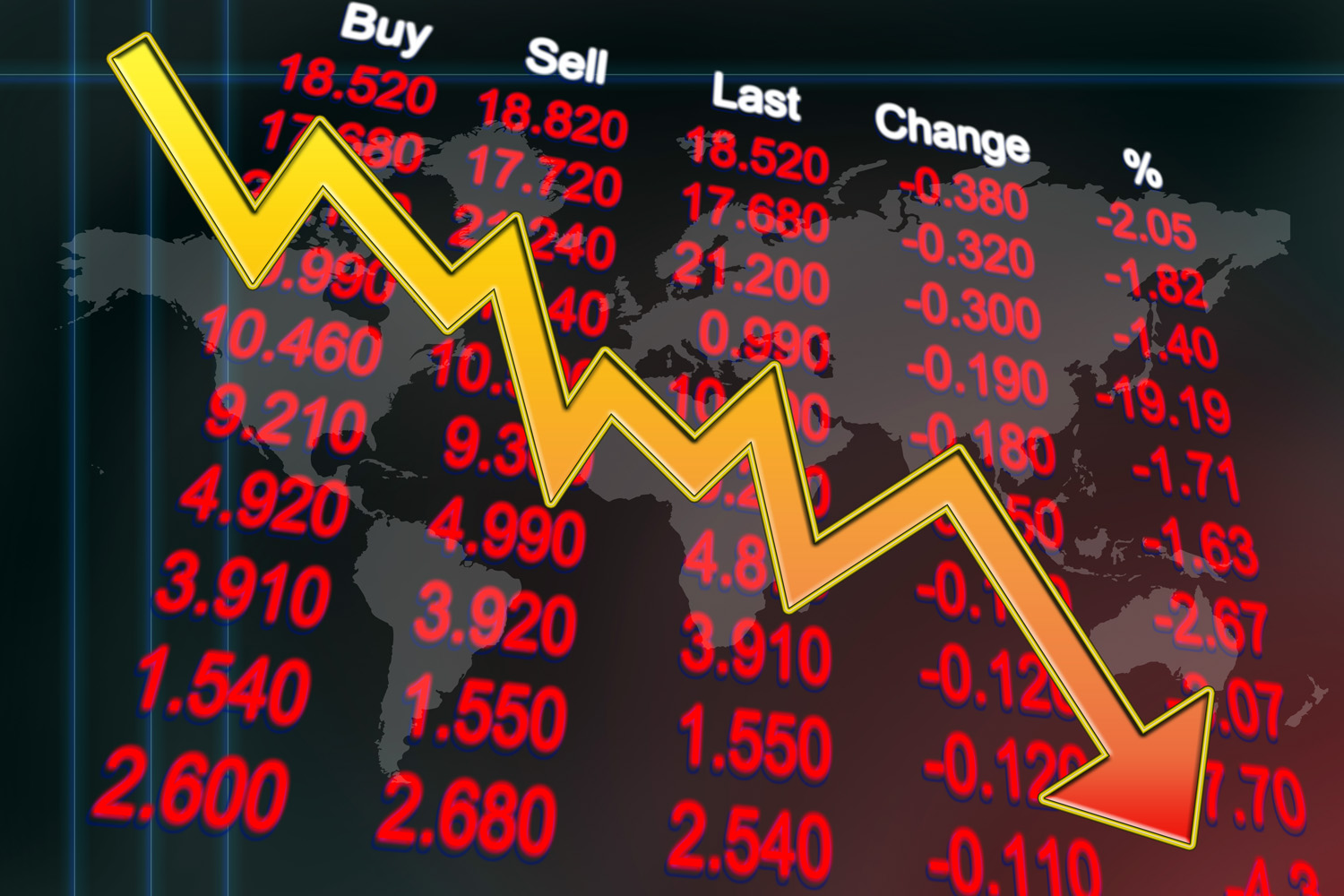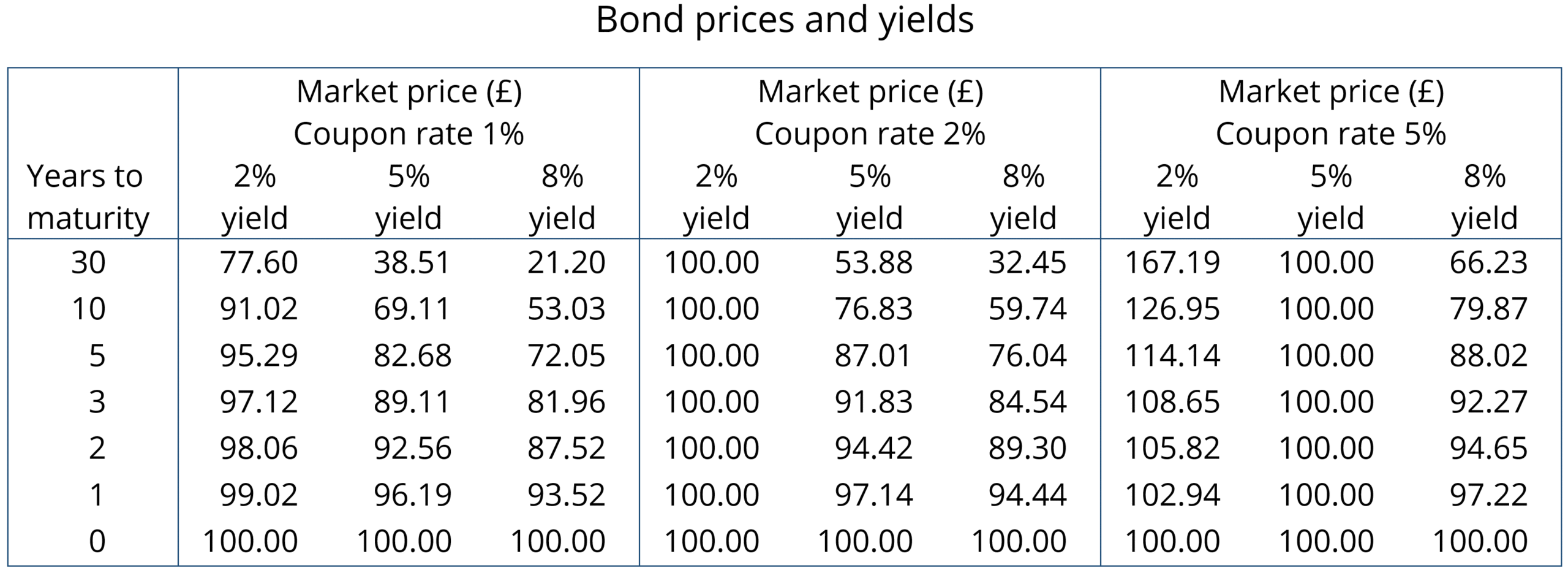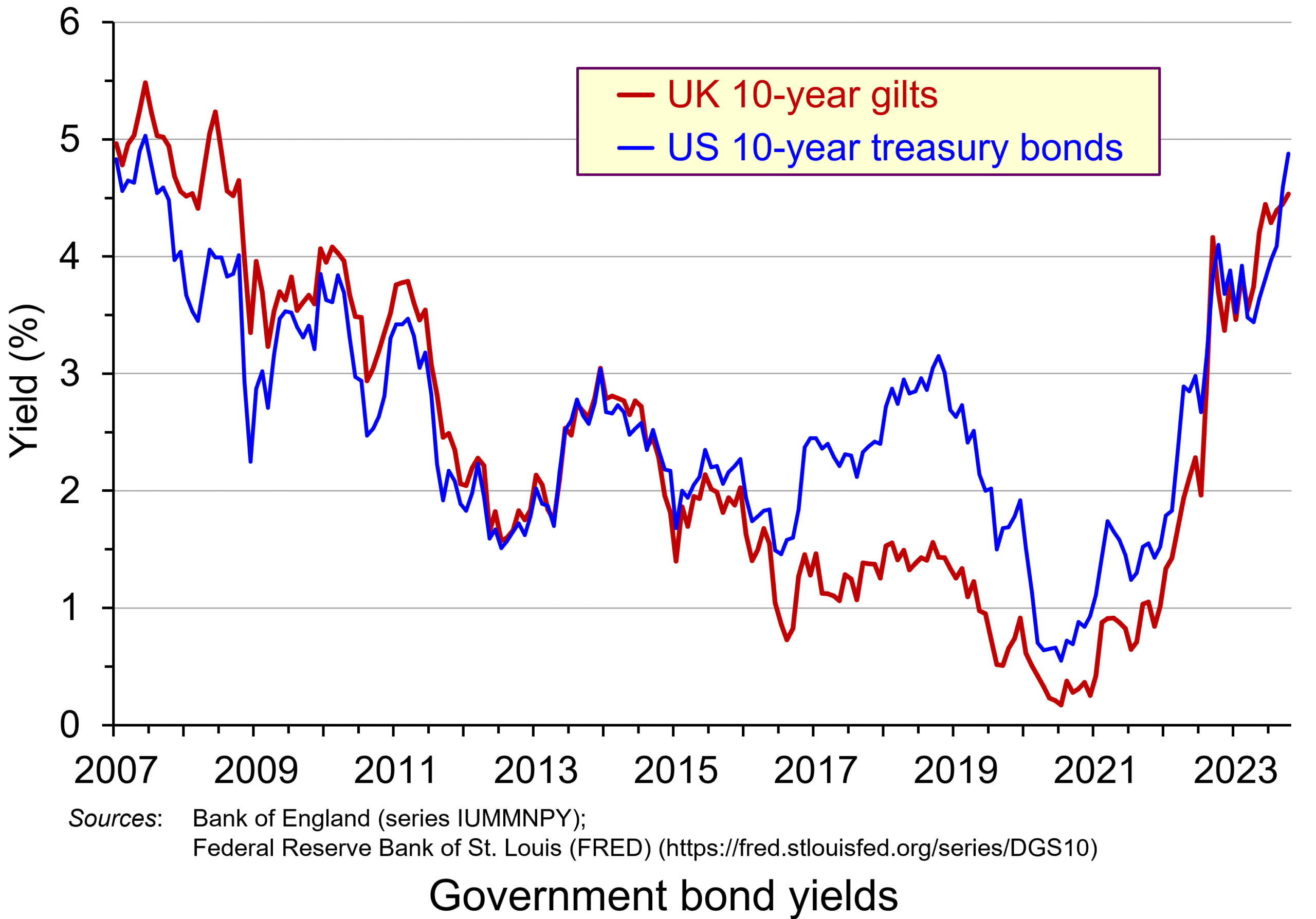 To finance budget deficits, governments have to borrow. They can borrow short-term by issuing Treasury bills, typically for 1, 3 or 6 months. These do not earn interest and hence are sold at a discount below the face value. The rate of discount depends on supply and demand and will reflect short-term market rates of interest. Alternatively, governments can borrow long-term by issuing bonds. In the UK, these government securities are known as ‘gilts’ or ‘gilt-edged securities’. In the USA they are known as ‘treasury bonds’, ‘T-bonds’ or simply ‘treasuries’. In the EU, countries separately issue bonds but the European Commission also issues bonds.
To finance budget deficits, governments have to borrow. They can borrow short-term by issuing Treasury bills, typically for 1, 3 or 6 months. These do not earn interest and hence are sold at a discount below the face value. The rate of discount depends on supply and demand and will reflect short-term market rates of interest. Alternatively, governments can borrow long-term by issuing bonds. In the UK, these government securities are known as ‘gilts’ or ‘gilt-edged securities’. In the USA they are known as ‘treasury bonds’, ‘T-bonds’ or simply ‘treasuries’. In the EU, countries separately issue bonds but the European Commission also issues bonds.
In the UK, gilts are issued by the Debt Management Office on behalf of the Treasury. Although there are index-linked gilts, the largest proportion of gilts are conventional gilts. These pay a fixed sum of money per annum per £100 of face value. This is known as the ‘coupon payment’ and the rate is set at the time of issue. The ‘coupon rate’ is the payment per annum as a percentage of the bond’s face value:

Payments are made six-monthly. Each issue also has a maturity date, at which point the bonds will be redeemed at face value. For example, a 4½% Treasury Gilt 2028 bond has a coupon rate of 4½% and thus pays £4.50 per annum (£2.25 every six months) for each £100 of face value. The issue will be redeemed in June 2028 at face value. The issue was made in June 2023 and thus represented a 5-year bond. Gilts are issued for varying lengths of time from 2 to 55 years. At present, there are 61 different conventional issues of bonds, with maturity dates varying from January 2024 to October 2073.
Bond prices
 Bonds can be sold on the secondary market (i.e. the stock market) before maturity. The market price, however, is unlikely to be the coupon price (i.e. the face value). The lower the coupon rate relative to current interest rates, the less valuable the bond will be. For example, if interest rates rise, and hence new bonds pay a higher coupon rate, the market price of existing bonds paying a lower coupon rate must fall. Thus bond prices vary inversely with interest rates.
Bonds can be sold on the secondary market (i.e. the stock market) before maturity. The market price, however, is unlikely to be the coupon price (i.e. the face value). The lower the coupon rate relative to current interest rates, the less valuable the bond will be. For example, if interest rates rise, and hence new bonds pay a higher coupon rate, the market price of existing bonds paying a lower coupon rate must fall. Thus bond prices vary inversely with interest rates.
The market price also depends on how close the bonds are to maturity. The closer the maturity date, the closer the market price of the bond will be to the face value.
Bond yields: current yield
A bond’s yield is the percentage return that a person buying the bond receives. If a newly issued bond is bought at the coupon price, its yield is the coupon rate.
However, if an existing bond is bought on the secondary market (the stock market), the yield must reflect the coupon payments relative to the purchase price, not the coupon price. We can distinguish between the ‘current yield’ and the ‘yield to maturity’.
The current yield is the coupon payment as a percentage of the current market price of the bond:

Assume a bond were originally issued at 2% (its coupon rate) and thus pays £2 per annum. In the meantime, however, assume that interest rates have risen and new bonds now have a coupon rate of 4%, paying £4 per annum for each £100 invested. To persuade people to buy old bonds with a coupon rate of 2%, their market prices must fall below their face value (their coupon price). If their price halved, then they would pay £2 for every £50 of their market price and hence their current yield would be 4% (£2/£50 × 100).
Bond yields: yield to maturity (YTM)
But the current yield does not give the true yield – it is only an approximation. The true yield must take into account not just the market price but also the maturity value and the length of time to maturity (and the frequency of payments too, which we will ignore here). The closer a bond is to its maturity date, the higher/lower will be the true yield if the price is below/above the coupon price: in other words, the closer will the market price be to the coupon price for any given market rate of interest.
A more accurate measure of a bond’s yield is thus the ‘yield to maturity’ (YTM). This is the interest rate which makes the present value of all a bond’s future cash flows equal to its current price. These cash flows include all coupon payments and the payment of the face value on maturity. But future cash flows must be discounted to take into account the fact that money received in the future is worth less than money received now, since money received now could then earn interest.
The yield to maturity is the internal rate of return (IRR) of the bond. This is the discount rate which makes the present value (PV) of all the bond’s future cash flows (including the maturity payment of the coupon price) equal to its current market price. For simplicity, we assume that coupon payments are made annually. The formula is the one where the bond’s current market price is given by:

Where: t is the year; n is the number of years to maturity; YTM is the yield to maturity.
Thus if a bond paid £5 each year and had a maturity value of £100 and if current interest rates were higher than 5%, giving a yield to maturity of 8%, then the bond price would be:

In other words, with a coupon rate of 5% and a higher YTM of 8%, the bond with a face value of £100 and five years to maturity would be worth only £88.02 today.
If you know the market price of a given bond, you can work out its YTM by substituting in the above formula. The following table gives examples.

The higher the YTM, the lower the market price of a bond. Since the YTM reflects in part current rates of interest, so the higher the rate of interest, the lower the market price of any given bond. Thus bond yields vary directly with interest rates and bond prices vary inversely. You can see this clearly from the table. You can also see that market bond prices converge on the face value as the maturity date approaches.
Recent activity in bond markets
Investing in government bonds is regarded as very safe. Coupon payments are guaranteed, as is repayment of the face value on the maturity date. For this reason, many pension funds hold a lot of government bonds issued by financially trustworthy governments. But in recent months, bond prices in the secondary market have fallen substantially as interest rates have risen. For those holding existing bonds, this means that their value has fallen. For governments wishing to borrow by issuing new bonds, the cost has risen as they have to offer a higher coupon rate to attract buyers. This make it more expensive to finance government debt.
 The chart shows the yield on 10-year government bonds. It is calculated using the ‘par value’ approach. This gives the coupon rate that would have to be paid for the market price of a bond to equal its face value. Clearly, as interest rates rise, a bond would have to pay a higher coupon rate for this to happen. (This, of course, is only hypothetical to give an estimate of market rates, as coupon rates are fixed at the time of a bond’s issue.)
The chart shows the yield on 10-year government bonds. It is calculated using the ‘par value’ approach. This gives the coupon rate that would have to be paid for the market price of a bond to equal its face value. Clearly, as interest rates rise, a bond would have to pay a higher coupon rate for this to happen. (This, of course, is only hypothetical to give an estimate of market rates, as coupon rates are fixed at the time of a bond’s issue.)
Par values reflect both yield to maturity and also expectations of future interest rates. The higher people expect future interest rates to be, the higher must par values be to reflect this.
 In the years following the financial crisis of 2007–8 and the subsequent recession, and again during the COVID pandemic, central banks cut interest rates and supported this by quantitative easing. This involved central banks buying existing bonds on the secondary market and paying for them with newly created (electronic) money. This drove up bond prices and drove down yields (as the chart shows). This helped support the policy of low interest rates. This was a boon to governments, which were able to borrow cheaply.
In the years following the financial crisis of 2007–8 and the subsequent recession, and again during the COVID pandemic, central banks cut interest rates and supported this by quantitative easing. This involved central banks buying existing bonds on the secondary market and paying for them with newly created (electronic) money. This drove up bond prices and drove down yields (as the chart shows). This helped support the policy of low interest rates. This was a boon to governments, which were able to borrow cheaply.
This has all changed. With quantitative tightening replacing quantitative easing, central banks have been engaging in asset sales, thereby driving down bond prices and driving up yields. Again, this can be seen in the chart. This has helped to support a policy of higher interest rates.
Problems of higher bond yields/lower bond prices
Although lower bond prices and higher yields have supported a tighter monetary policy, which has been used to fight inflation, this has created problems.
First, it has increased the cost of financing government debt. In 2007/8, UK public-sector net debt was £567bn (35.6% of GDP). The Office for Budget Responsibility forecasts that it will be £2702bn (103.1% of GDP in the current financial year – 2023/24). Not only, therefore, are coupon rates higher for new government borrowing, but the level of borrowing is now a much higher proportion of GDP. In 2020/21, central government debt interest payments were 1.2% of GDP; by 2022/23, they were 4.4% (excluding interest on gilts held in the Bank of England, under the Asset Purchase Facility (quantitative easing)).
 In the USA, there have been similar increases in government debt and debt interest payments. Debt has increased from $9tn in 2007 to $33.6tn today. Again, with higher interest rates, debt interest as a percentage of GDP has risen: from 1.5% of GDP in 2021 to a forecast 2.5% in 2023 and 3% in 2024. What is more, 31 per cent of US government bonds will mature next year and will need refinancing – at higher coupon rates.
In the USA, there have been similar increases in government debt and debt interest payments. Debt has increased from $9tn in 2007 to $33.6tn today. Again, with higher interest rates, debt interest as a percentage of GDP has risen: from 1.5% of GDP in 2021 to a forecast 2.5% in 2023 and 3% in 2024. What is more, 31 per cent of US government bonds will mature next year and will need refinancing – at higher coupon rates.
There is a similar picture in other developed countries. Clearly, higher interest payments leave less government revenue for other purposes, such as health and education.
Second, many pension funds, banks and other investment companies hold large quantities of bonds. As their price falls, so this reduces the value of these companies’ assets and makes it harder to finance new purchases, or payments or loans to customers. However, the fact that new bonds pay higher interest rates means that when existing bond holdings mature, the money can be reinvested at higher rates.
Third, bonds are often used by companies as collateral against which to borrow and invest in new capital. As bond prices fall, this can hamper companies’ ability to invest, which will lead to lower economic growth.
Fourth, higher bond yields divert demand away from equities (shares). With equity markets falling back or at best ceasing to rise, this erodes the value of savings in equities and may make it harder for firms to finance investment through new issues.
At the core of all these problems is inflation and budget deficits. Central banks have responded by raising interest rates. This drives up bond yields and drives down bond prices. But bond prices and yields depend not just on current interest rates, but also on expectations about future interest rates. Expectations currently are that budget deficits will be slow to fall as governments seek to support their economies post-COVID. Also expectations are that inflation, even though it is falling, is not falling as fast as originally expected – a problem that could be exacerbated if global tensions increase as a result of the ongoing war in Ukraine, the Israel/Gaza war and possible increased tensions with China concerning disputes in the China Sea and over Taiwan. Greater risks drive up bond yields as investors demand a higher interest premium.
Articles
Information and data
Questions
- Why do bond prices and bond yields vary inversely?
- How are bond yields and prices affected by expectations?
- Why are ‘current yield’ and ‘yield to maturity’ different?
- What is likely to happen to bond prices and yields in the coming months? Explain your reasoning.
- What constraints do bond markets place on fiscal policy?
- Would it be desirable for central banks to pause their policy of quantitative tightening?
 Mario Draghi, the ECB President, has indicated that the ECB is prepared to engage in further monetary stimulus. This is because of continuing weaknesses in the global economy and in particular in emerging markets.
Mario Draghi, the ECB President, has indicated that the ECB is prepared to engage in further monetary stimulus. This is because of continuing weaknesses in the global economy and in particular in emerging markets.
Although the ECB at its meeting in Malta on 22 October decided to keep both interest rates and asset purchases (€60 billion per month) at current levels, Mario Draghi stated at the press conference that, at its next meeting on December 3rd, the ECB would be prepared to cut interest rates and re-examine the size, composition and duration of its quantitative easing programme. He stopped short, however, of saying that interest rates would definitely be cut or quantitative easing definitely increased. He said the following:
“The Governing Council has been closely monitoring incoming information since our meeting in early September. While euro area domestic demand remains resilient, concerns over growth prospects in emerging markets and possible repercussions for the economy from developments in financial and commodity markets continue to signal downside risks to the outlook for growth and inflation. Most notably, the strength and persistence of the factors that are currently  slowing the return of inflation to levels below, but close to, 2% in the medium term require thorough analysis.
slowing the return of inflation to levels below, but close to, 2% in the medium term require thorough analysis.
In this context, the degree of monetary policy accommodation will need to be re-examined at our December monetary policy meeting, when the new Eurosystem staff macroeconomic projections will be available. The Governing Council is willing and able to act by using all the instruments available within its mandate if warranted in order to maintain an appropriate degree of monetary accommodation.”
Mario Draghi also argued that monetary policy should be supported by fiscal policy and structural policies (mirroring Japan’s three arrows). Structural policies should include actions to improve the business environment, including the provision of an adequate public infrastructure. This is vital to “increase productive investment, boost job creation and raise productivity”.
As far as fiscal policies are concerned, these “should support the economic recovery, while remaining in compliance with the EU’s fiscal rules”. In other words, fiscal policy should be expansionary, while staying within the limits set by the Stability and Growth Pact.
His words had immediate effects in markets. Eurozone government bond yields dropped to record lows and the euro depreciated 3% against the US dollar over the following 24 hours.
Webcasts
 ECB Press Conference on YouTube, Mario Draghi (22/10/15)
ECB Press Conference on YouTube, Mario Draghi (22/10/15)
 Draghi reloads bazooka FT Markets, Ferdinando Guigliano (22/10/15)
Draghi reloads bazooka FT Markets, Ferdinando Guigliano (22/10/15)
Articles
Mario Draghi: ECB prepared to cut interest rates and expand QE The Guardian, Heather Stewart (22/10/15)
Draghi signals ECB ready to extend QE Financial Times, Claire Jones and Elaine Moore (22/10/15)
Dovish Mario Draghi sends bond yields to new lows Financial Times, Katie Martin (23/10/15)
 What Draghi Said on QE, Policy Outlook, Global Risks and Inflation Bloomberg, Deborah Hyde (22/10/15)
What Draghi Said on QE, Policy Outlook, Global Risks and Inflation Bloomberg, Deborah Hyde (22/10/15)
ECB set to ‘re-examine’ stimulus policy at next meeting BBC News (22/10/15)
The global economy warrants a big dose of caution The Guardian, Larry Elliott (25/10/15)
ECB Press Conference
Introductory statement to the press conference (with Q&A) ECB, Mario Draghi (President of the ECB), Vítor Constâncio (Vice-President of the ECB) (22/10/15)
Questions
- Why is the ECB considering further expansionary monetary policy?
- What monetary measures can a central bank use to stimulate aggregate demand?
- Explain the effects of Mario Draghi’s announcement on bond and foreign exchange markets.
- What are the objectives of ECB monetary policy according to the its mandate?
- Should the ECB consider using quantitative easing to provide direct funding for infrastructure projects?
- What constraints does the EU’s Stability and Growth Pact impose on eurozone countries?
- What are the arguments for and against (a) the Bank of England and (b) the US Federal Reserve engaging in further QE?
- If the ECB does engage in an expanded QE programme, what will determine its effectiveness?
 The ECB president, Mario Draghi, has announced a new programme of ‘Outright Monetary Transactions (OMTs)’ to ease the difficulties of countries such as Greece, Spain, Portugal and Italy. The idea is to push down interest rates for these countries’ bonds. If successful, this will make it more affordable for them to service their debts.
The ECB president, Mario Draghi, has announced a new programme of ‘Outright Monetary Transactions (OMTs)’ to ease the difficulties of countries such as Greece, Spain, Portugal and Italy. The idea is to push down interest rates for these countries’ bonds. If successful, this will make it more affordable for them to service their debts.
OMTs involve the ECB buying these countries’ bonds on the secondary market (i.e. existing bonds). This will be limited to bonds with no more than three years to maturity. Although restricting purchases to the secondary market would not involve the ECB lending directly to these countries, the bond purchases should push down interest rates on the secondary market and this, in turn, should allow the countries to issue new bonds at lower rates on the primary market.
The OMT programme replaces the previous Securities Markets Programme (SMP), which began in May 2010. This too involved purchasing bonds on the secondary market. By the time of the last actions under SMP in January 2012, €212 billion of purchases had been made. Unlike the SMP, however, OMTs are in principle unlimited, with the ECB president, Mario Draghi, saying that the ECB would do ‘whatever it takes’ to hold the single currency together. This means that it will buy as many bonds on the market as are necessary to bring interest rates down to sustainable levels.
Critics, however, argue that this will still not be enough to stimulate the eurozone economy and help bring countries out of recession. They give two reasons.
The first is that OMTs differ from the quantitative easing programmes used in the UK and USA. OMTs would not increase the eurozone money supply as the ECB would sell other assets to offset the bond purchases. This process is known as ‘sterilisation’, which is defined as actions taken by a central bank to offset the effects of foreign exchange flows or its own bond transactions so as to leave money supply unchanged.
The second reason is that OMTs will be conducted only if countries stick to previously agreed strong austerity measures. This is something that it looking increasingly unlikely as protests against the cuts mount in countries such as Greece and Spain.
Articles
Super Mario to the rescue Financial Standard, Benjamin Ong (7/9/12)
Outright monetary transactions: Lowdown on bond-buying scheme Irish Times, Dan O’Brien (7/9/12)
Draghi comments at ECB news conference Reuters (6/9/12)
ECB’s Mario Draghi unveils bond-buying euro debt plan BBC News (6/9/12)
ECB Market Intervention: Outright Monetary Transactions (“OMT”) – A Preliminary Assessment Place du Luxembourg (9/9/12)
Evaluating the OMT: OrlMost Too late? Social Europe Journal, Andrew Watt (7/9/12)
Mario Draghi speech: what the analysts said The Telegraph (6/9/12)
ECB challenges German concern over bond-buying Irish Times, Derek Scally (26/9/12)
Draghi: efforts helping to support stable future MarketWatch, Tom Fairless (25/9/12)
 Mario and Mariano versus the man with the beard BBC News, Paul Mason (6/9/12)
Mario and Mariano versus the man with the beard BBC News, Paul Mason (6/9/12)
Good week for the euro – but also a warning BBC News, Stephanie Flanders (12/9/12)
The price of saving the eurozone BBC News, Robert Peston (26/9/12)
Special Report – Inside Mario Draghi’s euro rescue plan Reuters, Paul Carrel, Noah Barkin and Annika Breidthardt (25/9/12)
ECB to face biggest test on euro gambit Financial Times, Michael Steen and Peter Spiegel (25/9/12)
Press release
ECB: Monetary policy decisions ECB Press Release, (6/9/12)
Questions
- What are the key features of the OMT programme? How does it differ from the former Securities Markets Programme (SMP)?
- In what ways does the OMT programme differ from the quantitative easing programmes in the USA and UK?
- How will the ECB’s buying bonds in the secondary market influence the primary bond market? What will influence the size of the effect?
- How does sterilisation work in (a) the bond market; (b) the foreign exchange market?
- Why is it claimed that the OMT programme is a necessary but not sufficient condition for solving the crisis in the eurozone? What additional measures would you recommend and why?
- What are the risks associated with the OMT programme?
Original post (24/4/12)
 The result of the first round of the French presidential elections on 22 April make it likely that François Hollande will be the new president.
The result of the first round of the French presidential elections on 22 April make it likely that François Hollande will be the new president.
M. Hollande can be described as an austerity sceptic. In other words, he questions the wisdom of trying to meet the target agreed by eurozone countries of reducing public-sector deficits to no more than 3% of GDP.
If elected, M. Hollande promises to adopt a more Keynesian stance of stimulating demand in order to prevent a slide into recession. This would mean a reversal of cuts and a growth, at least temporarily, of the public-sector deficit.
Currently France’s deficit is much higher than the 3% target. In 2010 it was 7.1%; in 2011 it had fallen somewhat to 5.2%. But it is set to rise in 2012, thanks to the slowing economy in France and most of the rest of Europe.
And it is not just in France that ‘austerity sceptics’ are on the ascendant. In the Netherlands the centre right government of Mark Rutte fell. He was unable to get his coalition partners to agree to sufficient cuts to achieve the 3% target. And yet, the Netherland’s deficit is considerably lower than most eurozone countries’. In 2012 it is projected to be just 4.6% of GDP.
So if doubts about the 3% target could lead to a change in policy in the Netherlands and France, what hope is there that the targets could be adhered to by countries with much larger deficits and where the pain of the cuts is already causing political turmoil?
The growth in austerity scepticism has spooked the markets. The day following M. Hollande’s first round victory and the fall of Mark Rutte’s government, stock markets around Europe plummeted and bond prices rose. The higher bond prices will make it even harder for governments to refinance maturing government debt. Take the case of France. As Robert Peston remarks in his article below:
According to IMF figures, 59% of France’s government debt is held overseas – which means that well over half of all lending to the French state is not motivated by sentimentality or patriotism in any way.
To put that figure into context, just 24.8% of UK general government debt is provided by foreigners.
Perhaps more relevantly, the French government has to borrow a colossal sum equivalent to 18.2% of GDP this year and 19.5% next year to finance debt that is maturing and the current deficit.
So what are the implications of the rise in austerity scepticism? Will it make deficits harder to finance? Will a collapse of confidence push the eurozone into a deep recession. Might the eurozone break apart? Or will a dose of Keynesian policies turn the tide and allow growth to resume, making it easier to service government debts? The following articles explore the issues?
Update (7/5/12)
François Hollande was indeed elected president on 6 May. The question now is to what extent he will be able to enact measures to simulate the economy. In his campaign he had talked about renegotiating the European treaty on budget discipline. Angela Merkel, responding to M. Hollande’s victory, said that the European fiscal treaty had been agreed and could not be renegotiated. Nevertheless, she said she was happy to consider new growth strategies that did not involve increased budget deficits.
Articles
François Hollande’s potential spending spree in France has caused concern in austerity Europe The Telegraph, Bruno Waterfield (23/4/12)
European turmoil, American collateral Guardian, Robin Wells (24/4/12)
Political risk returns to eurozone debt crisis Financial Times, Richard Milne (23/4/12)
The rise of Europe’s austerity foes Business Spectator, Karen Maley (23/3/12)
Europe: A crisis of the centre BBC News, Paul Mason (24/4/12)
Is Hollande enemy or prisoner of finance? BBC News, Robert Peston (23/4/12)
President Hollande and the IMF BBC News, Stephanie Flanders (23/4/12)
French Bond Yields Test Hollande’s Economic Fealty Bloomberg, Mark Deen and Anchalee Worrachate (24/4/12)
Dutch and French politics bring us back to reality BusinessDay (South Africa), Ron Derby (24/4/12)
Crisis topples governments like dominos Deutsche Welle, Bernd Riegert (24/4/12)
Eurozone leaders push for growth BBC News (25/4/12)
Additonal articles (after 6 May)
Francois Hollande to set France on new course after win BBC News (7/5/12)
Europe elections: German Chancellor Angela Merkel welcomes Francois Hollande but warns Greece The Telegraph, 7/5/12)
A Merkel-Hollande bust-up? Less likely than you might think Guardian, Philip Oltermann (7/5/12)
Merkel Rejects Stimulus in Challenge to Hollande BloombergBusinessweek, Patrick Donahue and Tony Czuczka (7/5/12)
François Hollande’s chemistry with Angela Merkel crucial for Europe Guardian, Ian Traynor (7/5/12)
Q&A: End of austerity? BBC News (7/5/12)
Austerity and the people’s verdict Guardian letters, Shanti Chakravarty and others (8/5/12)
Europe: The big debate BBC News, Stephanie Flanders (11/5/12)
Data
European Economy: Economic data Economic and Financial Affairs, European Commission
Eurozone Statistics ECB
French Economic Statistics INSEE, National Institute of Statistics and Economic Studies
Netherlands Statistics CBS, Statistics Netherlands
Questions
- Why do investors worry about the pursuit of Keynesian expansionary fiscal policies? Are their fears justified?
- How important is it for countries, such as the Netherlands, to retain their AAA credit rating?
- What determines bond yields?
- Do a search to find the policies advocated by M. Hollande. Assess the likely economic impact of these policies.
- What conditions are necessary for the pursuit of a tough austerity line to achieve economic growth in (a) the short term of 12 to 18 months; (b) the longer term of several years?
- Is an increased use of public-private partnerships a solution to finding a way of delivering greater infrastructure expenditure without increasing the short-term deficit?
Every six months the Bank of England publishes its Financial Stability Report. “It aims to identify the major downside risks to the UK financial system and thereby help financial firms, authorities and the wider public in managing and preparing for these risks.”
In the latest report, published on 17 December 2010, the Bank expresses concern about the UK’s exposure to problems overseas. The two most important problems are the continuing weaknesses of a number of banks and the difficulties of certain EU countries in repaying government bonds as they fall due and borrowing more capital at acceptable interest rates. As the report says:
Sovereign and banking system concerns have re-emerged in parts of Europe. The IMF and European authorities proposed a substantial package of support for Ireland. But market concerns spilled over to several other European countries. At the time of writing, contagion to the largest European banking systems has been limited. In this environment, it is important that resilience among UK banks has improved over the past year, including progress on refinancing debt and on raising capital buffers. But the United Kingdom is only partially insulated given the interconnectedness of European financial systems and the importance of their stability to global capital markets.
The Bank identifies a number of specific risks to the UK and global financial systems and examines various policy options for tackling them. The following articles consider the report.
Articles
Bank warns of eurozone risks to UK as EU leaders meet Independent, Sean O’Grady (17/12/10)
Deep potholes on the road to recovery Guardian, Nils Pratley (17/12/10)
It’s reassuring that regulators are still worried about financial stability The Telegraph, Tracy Corrigan (17/12/10)
Europe is still searching for stability and the UK must find it too Independent, Hamish McRae (17/12/10)
Shafts of light between the storm clouds The Economist blogs: ‘Blighty’ (17/12/10)
Report
Financial Stability Report, December 2010: Overview Bank of England
Financial Stability Report, December 2010: Links to rest of report Bank of England
Questions
- What are the most important financial risks facing (a) the UK; (b) eurozone countries?
- What is the significance of the rise in banks’ tier-1 capital ratios since 2007?
- Which is likely to be more serious over the coming months: banking weaknesses or sovereign debt? Explain.
- What is being done to reduce the risks of sovereign default?
- Why might the weaker EU countries struggle to achieve economic growth over the next two or three years?
- How do interest rates on government debt, as expressed by bond yields, compare with historical levels? What conclusions can you draw from this?
- What is likely to happen to bond yields in the USA, the UK and Germany over the coming months?
- What has been the effect of the extra £200 billion that the Bank of England injected into the banking system through its policy of quantitative easing?
 To finance budget deficits, governments have to borrow. They can borrow short-term by issuing Treasury bills, typically for 1, 3 or 6 months. These do not earn interest and hence are sold at a discount below the face value. The rate of discount depends on supply and demand and will reflect short-term market rates of interest. Alternatively, governments can borrow long-term by issuing bonds. In the UK, these government securities are known as ‘gilts’ or ‘gilt-edged securities’. In the USA they are known as ‘treasury bonds’, ‘T-bonds’ or simply ‘treasuries’. In the EU, countries separately issue bonds but the European Commission also issues bonds.
To finance budget deficits, governments have to borrow. They can borrow short-term by issuing Treasury bills, typically for 1, 3 or 6 months. These do not earn interest and hence are sold at a discount below the face value. The rate of discount depends on supply and demand and will reflect short-term market rates of interest. Alternatively, governments can borrow long-term by issuing bonds. In the UK, these government securities are known as ‘gilts’ or ‘gilt-edged securities’. In the USA they are known as ‘treasury bonds’, ‘T-bonds’ or simply ‘treasuries’. In the EU, countries separately issue bonds but the European Commission also issues bonds.![]()
 Bonds can be sold on the secondary market (i.e. the stock market) before maturity. The market price, however, is unlikely to be the coupon price (i.e. the face value). The lower the coupon rate relative to current interest rates, the less valuable the bond will be. For example, if interest rates rise, and hence new bonds pay a higher coupon rate, the market price of existing bonds paying a lower coupon rate must fall. Thus bond prices vary inversely with interest rates.
Bonds can be sold on the secondary market (i.e. the stock market) before maturity. The market price, however, is unlikely to be the coupon price (i.e. the face value). The lower the coupon rate relative to current interest rates, the less valuable the bond will be. For example, if interest rates rise, and hence new bonds pay a higher coupon rate, the market price of existing bonds paying a lower coupon rate must fall. Thus bond prices vary inversely with interest rates.![]()



 The chart shows the yield on 10-year government bonds. It is calculated using the ‘par value’ approach. This gives the coupon rate that would have to be paid for the market price of a bond to equal its face value. Clearly, as interest rates rise, a bond would have to pay a higher coupon rate for this to happen. (This, of course, is only hypothetical to give an estimate of market rates, as coupon rates are fixed at the time of a bond’s issue.)
The chart shows the yield on 10-year government bonds. It is calculated using the ‘par value’ approach. This gives the coupon rate that would have to be paid for the market price of a bond to equal its face value. Clearly, as interest rates rise, a bond would have to pay a higher coupon rate for this to happen. (This, of course, is only hypothetical to give an estimate of market rates, as coupon rates are fixed at the time of a bond’s issue.)  In the years following the financial crisis of 2007–8 and the subsequent recession, and again during the COVID pandemic, central banks cut interest rates and supported this by quantitative easing. This involved central banks buying existing bonds on the secondary market and paying for them with newly created (electronic) money. This drove up bond prices and drove down yields (as the chart shows). This helped support the policy of low interest rates. This was a boon to governments, which were able to borrow cheaply.
In the years following the financial crisis of 2007–8 and the subsequent recession, and again during the COVID pandemic, central banks cut interest rates and supported this by quantitative easing. This involved central banks buying existing bonds on the secondary market and paying for them with newly created (electronic) money. This drove up bond prices and drove down yields (as the chart shows). This helped support the policy of low interest rates. This was a boon to governments, which were able to borrow cheaply. In the USA, there have been similar increases in government debt and debt interest payments. Debt has increased from $9tn in 2007 to $33.6tn today. Again, with higher interest rates, debt interest as a percentage of GDP has risen: from 1.5% of GDP in 2021 to a forecast 2.5% in 2023 and 3% in 2024. What is more, 31 per cent of US government bonds will mature next year and will need refinancing – at higher coupon rates.
In the USA, there have been similar increases in government debt and debt interest payments. Debt has increased from $9tn in 2007 to $33.6tn today. Again, with higher interest rates, debt interest as a percentage of GDP has risen: from 1.5% of GDP in 2021 to a forecast 2.5% in 2023 and 3% in 2024. What is more, 31 per cent of US government bonds will mature next year and will need refinancing – at higher coupon rates.



